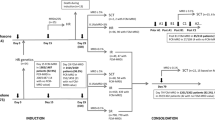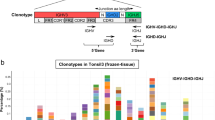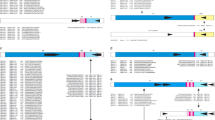Abstract
PCR of clonally rearranged immunoglobulin heavy chain (IgH) gene sequences is increasingly used for detection of minimal residual disease (MRD) in lymphoid malignancies. Inherent quantitating problems are the main drawbacks of traditional PCR technologies. These limitations have been overcome by the recently developed real-time quantitative PCR (RQ PCR) technology. However, clinical application of the few published RQ PCR assays targeting immune gene rearrangements is hampered by the expensive and time-consuming need for individual hybridization probes for each patient. We have developed a new RQ PCR strategy targeting clonally rearranged IgH sequences that solves this problem. The method uses only two different JHhybridization probes and four downstream JH primers homologous to consensus germline JH gene segments. In combination with an allele-specific upstream (ASO) primer the consensus JH probes and primers allow quantitation of about 90% of possible IgH rearrangements. In a series of 22 B-lineage ALL the new assay allowed the detection of one to 10 blasts in a background of 105 normal cells. To prove the clinical utility we quantified MRD in 23 follow-up samples of six ALL patients with the new assay in comparison with a published RQ PCR technique that used individually designed primer/probe sets. We showed that the sensitivity of the new RQ PCR assay was slightly higher for four of the six cases and about 100-fold higher for one case, enabling detection of an increasing MRD level as an indicator of subsequent relapse 44 weeks earlier compared to the ASO probe assay in this particular patient. The results suggest, that the novel RQ PCR assay is a rapid, technically simple, reliable, and sensitive alternative to traditional quantification assays and simplifies current approaches of monitoring MRD in clinical trials.
This is a preview of subscription content, access via your institution
Access options
Subscribe to this journal
Receive 12 print issues and online access
$259.00 per year
only $21.58 per issue
Buy this article
- Purchase on Springer Link
- Instant access to full article PDF
Prices may be subject to local taxes which are calculated during checkout


Similar content being viewed by others
References
Foroni L . Investigation of minimal residual disease in childhood and adult acute lymphoblastic leukemia by molecular analysis Br J Haematol 1999 105: 7–24
Cave H, Guidal C, Rohrlich P, Delfau MH, Broyart A, Lescoeur B, Rahimy C, Fenneteau O, Monplaisir N, d'Auriol L, Elio J, Vilmer E, Grandchamp B . Prospective monitoring and quantitation of residual blasts in childhood acute lymphoblastic leukemia by polymerase chain reaction study of δ and γ T-cell receptor genes Blood 1994 83: 1892–1902
Brisco MJ, Hughes E, Neoh SH, Sykes PJ, Bradstock K, Enno A, Szer J, McCaul K, Morley AA . Relationship between minimal residual disease and outcome in adult acute lymphoblastic leukemia Blood 1996 87: 5251–5256
Roberts WM, Estrov Z, Ouspenskaia MV, Johnston DA, McClain KL, Zipf TF . Measurement of residual disease during remission in childhood acute lymphoblastic leukemia New Engl J Med 1997 336: 317–323
Cave H, van der Werff ten Bosch J, Suciu S, Guidal C, Waterkeyn C, Otten J, Bakkus M, Thielemans K, Grandchamp B, Vilmer E, Nelken B, Fournier M, Boutard P, Lebrun E, Mechinaud F, Garand R, Robert A, Dastugue N, Plouvier E, Racadot E, Ferster A, Gyselinck J, Fenneteau O, Duval M, Solbu G, Manel AM . Clinical significance of minimal residual disease in childhood acute lymphoblastic Leukemia New Engl J Med 1998 339: 591–598
Van Dongen JJ, Seriu T, Panzer-Grunmayer ER, Biondi A, Pongers-Willemse MJ, Corral L, Stolz F, Schrappe M, Masera G, Kamps WA, Gadner H, van Wering ER, Ludwig WD, Basso G, de Bruijn MA, Cazzaniga G, Hettinger K, van der Does-van den Berg A, Hop WC, Riehm H, Bartram CR . Prognostic value of minimal residual disease in acute lymphoblastic leukemia in childhood Lancet 1998 352: 1731–1738
Gruhn B, Hongeng S, Yi H, Hancock ML, Rubnitz JE, Neale GAM, Kitchingman GR . Minimal residual disease after intensive induction therapy in childhood acute lymphoblastic leukemia predicts outcome Leukemia 1998 12: 675–681
Corradini P, Ladetto M, Pileri A, Tarella C . Clinical relevance of minimal residual disease monitoring in non-Hodgkin's lymphomas: a critical reappraisal of molecular strategies Leukemia 1999 13: 1691–1695
Gerard CJ, Olsson K, Ramanathan R, Rading C, Hanania EG . Improved quantitation of minimal residual disease in multiple myeloma using real-time polymerase chain reaction and plasmid-DNA complemetarity determining region III standards Cancer Res 1998 58: 3957–3964
Elsworth AM, Evans PAS, Morgan GJ, Kinsey SE, Shiach CR . Quantitative PCR of the immunoglobulin heavy chain gene using genomic DNA Br J Haematol 1996 95: 700–703
Dölken L, Schüler F, Dölken G . Quantitative detection of t(14;18)-positive cells by real-time quantitative PCR using fluorogenic probes BioTechniques 1998 25: 1058–1064
Luthra R, McBride JA, Cabanillas F, Sarris A . Novel 5′ exonuclease-based real-time PCR assay for the detection of t(14;18)(q32;q21) in patients with follicular lymphoma Am J Pathol 1998 153: 63–68
Pongers-Willemse MJ, Verhagen OJHM, Tibbe GJM, Wijkhuijs AJM, de Haas V, Roovers E, Van der Schoot CE, Van Dongen JJM . Real-time quantitative PCR for the detection of minimal residual disease in acute lymphoblastic leukemia using junctional region specific TaqMan probes Leukemia 1998 12: 2006–2014
Olsson K, Gerard CJ, Zehnder J, Jones C, Ramanathan R, Reading C, Hanania EG . Real-time t(11;14) and t(14;18) PCR assays provide sensitive and quantitative assessment of minimal residual disease (MRD) Leukemia 1999 13: 1833–1842
Holland PM, Abramson RD, Watson R, Gelfand DH . Detection of specific polymerase chain reaction product by utilizing the 5′–3′ exonuclease activity of Thermus aquaticus DNA polymerase Proc Natl Acad Sci USA 1991 88: 7276–7280
Gibson UE, Heid CA, Williams PM . A novel method for real time quantitative RT-PCR Genome Res 1996 6: 995–1001
Heid CA, Stevens J, Livak KJ, Williams PM . Real time quantitative PCR Genome Res 1996 6: 321–328
Linke B, Bolz I, Pott C, Hiddemann W, Kneba M . Use of UITma DNA polymerase improves the PCR detection of rearranged immunoglobulin heavy chain CDR3 junctions Leukemia 1995 9: 2133–2137
Linke B, Bolz I, Fayyazi A, von Hofen M, Pott C, Bertram J, Hiddemann W, Kneba M . Automated high resolution PCR fragment analysis for identification of clonally rearranged immunoglobulin heavy chain genes Leukemia 1997 11: 1055–1062
Linke B, Pyttlich J, Tiemann M, Suttorp M, Parwaresch R, Hiddemann W, Kneba M . Identification and structural analysis of rearranged immunoglobulin heavy chain genes in lymphomas and leukemias Leukemia 1995 9: 840–847
Flanagan JG, Rabbitts TH . The sequence of a human immunoglobulin epsilon heavy chain constant region gene, and evidence for three non-allelic genes EMBO J 1982 1: 655–660
Mattila PS, Schugk HW, Makela O . Extensive allelic sequence variation in the J region of the human immunoglobulin heavy chain gene locus Eur J Immunol 1995 25: 2578–2582
Ichihara Y, Matsuoka H, Kurosawa Y . Organization of human immunoglobulin heavy chain diversity gene loci EMBO J 1988 7: 4141–4150
Huang C, Stewart AK, Schwartz RS, Stollar BD . Immunoglobulin heavy chain gene expression in peripheral blood lymphocytes J Clin Invest 1992 89: 1331–1343
Mortari F, Wang JY, Schroeder HW . Mixed population of VH gene segments and CDR3 distribution in the expressed Cα and Cγ repertoires J Immunol 1993 150: 1348–1357
Corbett SJ, Tomlinson IM, Sonnhammer, Buck D, Winter G . Sequence of the human immunoglobulin diversity (D) segment locus: a systematic analysis provides no evidence for the use of DIR segments, inverted D segments, ‘minor’ D segments or D–D recombination J Mol Biol 1997 270: 587–597
Brezinschek HP, Brezinschek RI, Lipsky PE . Analysis of the heavy chain repertoire of human peripheral B cells using single-cell polymerase chain reaction J Immunol 1995 155: 190–202
Nizet Y, Martiat P, Vaerman JL, Philippe M, Wildmann C, Staelens JP, Cornu G, Ferrant A, Michaux JL Sokal G . Follow-up of residual disease (MRD) in B lineage akute leukemia using a simplified PCR strategy: evolution of MRD rather than its detection is correlated with clinical outcome Br J Haematol 1991 79: 205–210
Foroni L, Coyle LA, Papaioannou M, Yaxley JC, Cole Sinclai MF, Chim JS, Cannel P, Secker-Walker LM, Mehta AB, Prentice HG, Hoffbrand AV . Molecular detection of minimal residual disease in adult and childhood acute lymphoblastic leukemia reveals differences in treatment response Leukemia 1997 11: 1732–1741
Sykes PJ, Neoh SH, Brisco MJ, Hughes E, Condon J, Morley AA . Quantitation of targets for PCR by use of limiting dilution BioTechniques 1992 13: 444–449
Mayer SP, Giamelii J, Sandoval C, Roach AS, Ozkaynak MF, Tugal O, Rovera G, Jayabose S . Quantitation of leukemia clone-specific antigen gene rearrangements by a single-step PCR and fluorescence-based detection method Leukemia 1999 13: 1843–1852
Acknowledgements
This work was supported by Deutsche Forschungsgemeinschaft Grant KN 422/1-1.
Author information
Authors and Affiliations
Rights and permissions
About this article
Cite this article
Brüggemann, M., Droese, J., Bolz, I. et al. Improved assessment of minimal residual disease in B cell malignancies using fluorogenic consensus probes for real-time quantitative PCR. Leukemia 14, 1419–1425 (2000). https://doi.org/10.1038/sj.leu.2401831
Received:
Accepted:
Published:
Issue Date:
DOI: https://doi.org/10.1038/sj.leu.2401831
Keywords
This article is cited by
-
Is Next-Generation Sequencing the way to go for Residual Disease Monitoring in Acute Lymphoblastic Leukemia?
Molecular Diagnosis & Therapy (2017)
-
Next-generation sequencing and real-time quantitative PCR for minimal residual disease detection in B-cell disorders
Leukemia (2014)
-
Minimal residual disease in acute lymphoblastic leukemia: optimal methods and clinical relevance, pitfalls and recent approaches
Medical Oncology (2014)



